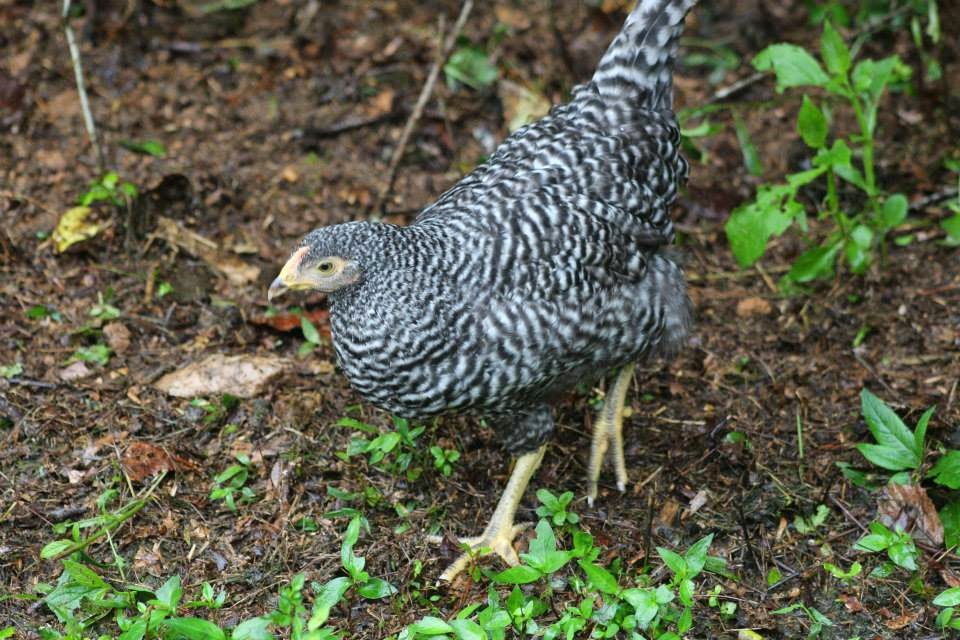Ameraucanas
Ameraucanas are a true breed of chicken - meaning that they will always breed true. If you breed an Ameraucana to an Ameraucana, you will get an Ameraucana. Of course, if you breed some colors to others you will end up with colors that are not accepted. You can breed blue to black and splash, and wheaten can be bred to blue wheaten and splash wheaten. Don't go mixing colors unless you understand the genetics and know you're getting, or if you want Easter Eggers.These chickens lay blue eggs, some are green tinted but a robin's blue egg is preferred. They have muffs and beards, also.
You can find more about Ameraucanas here.
Araucanas
Araucanas, like Ameraucanas, are a true breed of chicken. Breeding an Araucana to an Araucana will result in an Araucana, but again there are different color varieties. Learn the color genetics before mixing colors, unless you want Easter Eggers.They lay blue eggs, and are tufted. Tufts are actual feathers (not fluff, like muffs, but those are feathers too) that stick out the side of their face and curl back. They are also rumpless. Rumplessness is a fatal gene, so breeding a rumpless chicken to a rumpless chicken with result in 50% rumpless, 25% tailed, and 25% never hatch because they have two copies of the gene.
You can find more about Araucanas here.
Easter Eggers
Easter Eggers are not a true breed of chicken. They do not breed true, and so they are not suitable for showing. This is not bad, however, as they are very unique, coming in all sorts of colors and personalities and laying many colors of eggs.Most of the time, Easter Eggers are muffed and bearded, but they can also be clean faced. Being mutts, they can lay either blue or green eggs. Some Easter Eggers lay brown eggs, but, personally, if it lays a brown egg I don't consider it an Easter Egger. I would call it a Barnyard Mix or something similar.
You can find more about Easter Eggers here.
Olive Eggers
Olive Eggers are, essentially, Easter Eggers. They are not a true breed and are not showable. They are mixes between blue or green egg layers (whether that is Easter Eggers, Ameraucanas, or Araucanas) and a dark chocolate egg layer (such as a Welsummer, Marans, or Pendescenda).The characteristics of Olive Eggers really depends on the parents. If a Marans was used in the cross, they might have feathered legs, to get the blue egg gene, they might be tufted or bearded and muffed. The cross will result in a bird laying a dark green olive colored egg - an 'Olive Egger'.
You can find more about Olive Eggers here.
What Do You Have?
Where did your chicken come from?
If your chicken came from a hatchery, whether it was Murray McMurray, Ideal, Meyers, or Cackle - most likely it is an Easter Egger. A hatchery bird is an Easter Egger. Some hatcheries sell Easter Eggers and Ameraucanas, but I can not attest to the quality of these 'Ameraucanas', as I have never purchased any myself.If your bird came from a breeder, it might be an Ameraucana or Araucana - but Araucanas are very rare and you probably don't have one. Some people buy chicks from hatcheries that are labeled as Ameraucanas, and then they sell them as Ameraucanas because they don't know that their chickens are, in fact, Easter Eggers.
Is it a specific Ameraucana or Araucana color variety?
You can find a list of accepted Ameraucana and Araucana color varieties in the breed links above. If your chicken is not one of those colors, it is probably an Easter Egger, or maybe an Olive Egger. Leg color is also an indicator - Ameraucanas have slate (blueish) legs. Green legs mean it's an Easter Egger (or Olive Egger), but some Easter Eggers have slate legs.Does it have facial feathers?
If the bird is clean faced, meaning, like most chickens, it doesn't have muffs, a beard, or tufts, then it is an Easter Egger or Olive Egger. Ameraucanas have muffs and beards while Araucanas will have tufts. The gene for muffs and beards is the same gene, so you can't have a bearded muffless chicken or a muffed beardless chicken. Generally, Easter Eggers are some part Ameraucana, and they will often have beards and muffs, but not always. Beards and muffs are small, fluffy feathers under the bird's beak and on the sides of its face. Tufts, on the other hand, are harder, like the other feathers the chicken has, and come out of the sides of the chicken's face, sometimes curving backward.What was it sold to you as?
If the chicken was labeled as an Ameraucana or Araucana, usually that's what they are. If it says 'Americana', 'Aracana', or with similar misspellings, odds are its an Easter Egger. Most people breed Olive Eggers purposefully, and sell them as Olive Eggers. If you see 'Americana Hatching Eggs' on EBay or Craigslist, just remember they're probably Easter Eggers. Another thing to look for is the color variety. If the ad says 'Black Ameraucana Hatching Eggs' rather than just 'Ameraucana Hatching Eggs', its more likely to be real Ameraucanas.
~
Please comment below! Follow me on Google+ in the upper right and g+1 me at the top left on the bar! May you have a wonderful day full of chickens.




.JPG)






